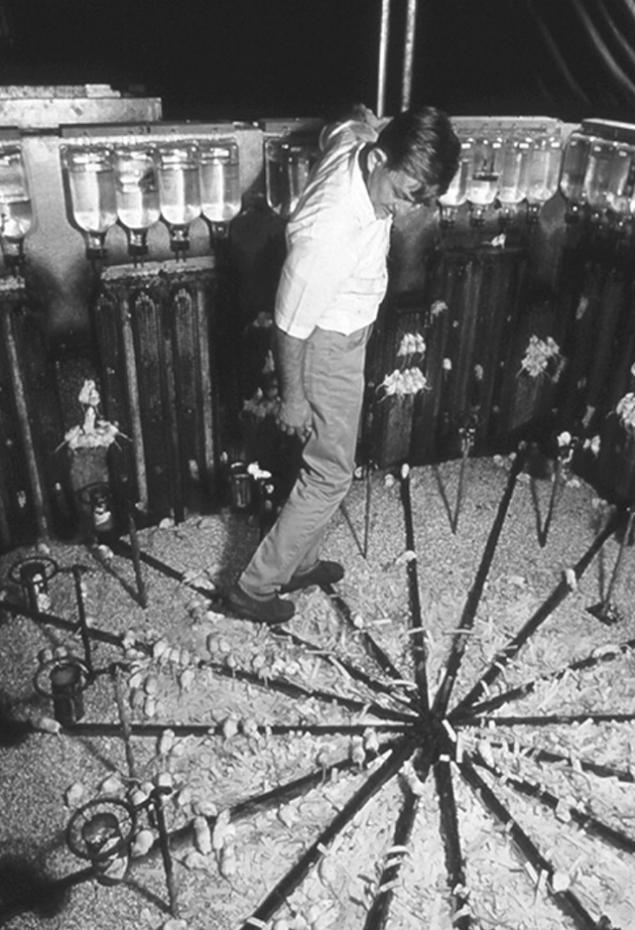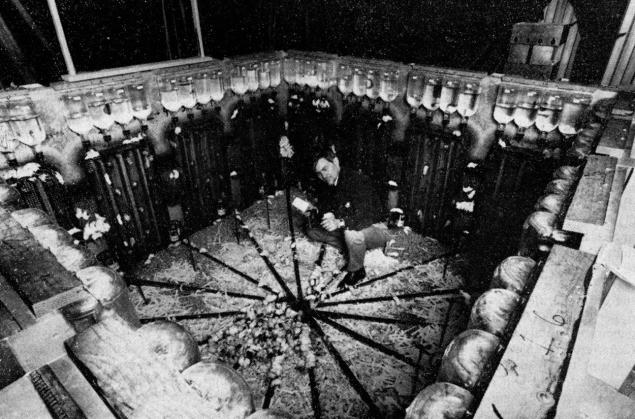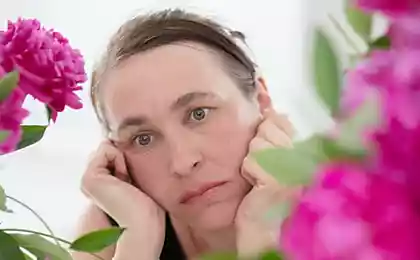839
Universe 25: mice destroyed paradise
The Rise and Fall of an ideal miraAmerikansky scientist ethologist John Calhoun held a series of fascinating experiments in the 60-70 years of the twentieth century. As an experimental D. Calhoun always chose rodents, although the ultimate goal of the research was always a prediction for the future of human society. As a result of numerous experiments on rodent colonies Calhoun has formulated a new term, "behavioral sink» (behavioral sink), indicating a transition to a destructive and deviant behavior in terms of overpopulation and overcrowding. His research Calhoun acquired a certain notoriety in the 60s, as many people in Western countries, is experiencing the post-war baby boom, began to think about how overpopulation affect public institutions and on each individual in particular.

His most famous experiment that made us think about the future of a whole generation, the scientist held in 1972 in conjunction with the National Institute of Mental Health (NIMH). The aim of the experiment was to analyze the impact of its population density in the behavioral patterns of rodents.
Calhoun built a haven for mice in the laboratory. It was created by a tank the size of two by two meters and a height of half a meter from where guinea could not get out. Inside the tank to maintain a constant comfortable temperature for mice (+20 ° C), present in abundant food and water, created numerous nests for the females. Each week, the tank is cleaned and maintained in a constant state of cleanliness, we had taken all the necessary security measures: eliminates the appearance of predators in the tank, or the occurrence of massive infections. The experimental mice were under the constant supervision of veterinarians, their health status is constantly monitored. The system providing food and water was so thought that 9500 mice could eat at the same time without experiencing any discomfort, and 6144 mice consume water, and without experiencing any problems. Space for mice was more than enough, the first problem of the lack of shelter could only arise when the population of more than 3840 individuals. However, such a number of mice had not been in the tank, the maximum size of the population observed at the level of 2200 mice.

The experiment started with a moment of space inside the tank four pairs of healthy mice, which took a little time to get comfortable, to realize in what a tale they hit the mouse, and begin to multiply rapidly. Calhoun called the period of development of phase A, but since the birth of the first cubs began the second stage of B. This stage of exponential growth of population in the tank under ideal conditions, the number of mice doubling every 55 days. Starting with the 315 days of the experiment, the rate of population growth has slowed, and now the number has doubled every 145 days, which marked the entry into the third phase C. At this point in the tank were about 600 mice formed a hierarchy and some social life. It has become physically less space than previously.
There was a category of "excluded", who were being driven into the center of the tank, they often become victims of aggression. To distinguish a group of "outcasts" could be bitten by the tails, tear hair and traces of blood in the body. Les Miserables consisted mainly of young individuals, who did not find for themselves the role of the social hierarchy in mouse. The problem of lack of appropriate social roles was caused by the fact that under ideal conditions the tank mice lived long aging mice do not make room for the young rodents. So often aggression was aimed at a new generation of individuals born in the tank. After the expulsion of the males were broken psychologically, they showed less aggression, unwilling to defend their pregnant females and to perform any social role. Although they occasionally attacked any other individuals of the society, "excluded" or to any other mouse.
Females, preparing for birth, became increasingly nervous as a result of increased inactivity among males, they become more vulnerable to random attacks. As a result, the female began to show aggression, often fight to protect the offspring. However, paradoxically, the aggression was not directed only at others, no less aggressiveness manifested toward their children. Often females kill their cubs and moved to the top slot, they become aggressive and hermits refused to reproduction. As a result, the birth rate has dropped substantially, and the mortality rate of young animals reached significant levels.
The average age of the mouse in the latter stages of the existence of the mouse paradise was 776 days, that 200 days exceeds the upper limit of reproductive age h4> Soon the last stage of the existence of the mouse paradise - phase D or the phase of death, as it is called John Calhoun. The symbol of this stage is the emergence of a new category of mice, called "beautiful." These include males, showing uncharacteristic for the kind of behavior, refusing to fight and fight for territory and females, showed no desire to mate, are prone to a passive lifestyle. "Beautiful" only we ate, drank, slept, and purified their skins, avoiding conflicts and the implementation of any social functions. This name they received because unlike most of the other inhabitants of the tank on their body did not have signs of cruel battle, scars and hair torn out, their narcissism, and narcissism have become legendary. Also, the researcher was struck by the lack of desire to have "beautiful" to mate and breed among the latest wave of births in the tank "beautiful" and female single, refusing to multiply and escaping into the upper slot of the tank, became the majority.
The refusal to accept the numerous challenges escape from stress, from a life of struggle and overcoming - a "first death» in the terminology of John Calhoun, or the death of the spirit, which is inevitably comes the second death, this time body h4> One Calhoun asked about the reasons for the emergence of a group of rodents "beautiful." Calhoun had a direct analogy with the man, explaining that the key feature of the person, his natural destiny - is to live in the face of pressure, tension and stress. Mice, give up the struggle, choosing Unbearable Lightness of Being, have become autistic, "handsome", capable of only the most primitive functions of the absorption of food and sleep. From the complex and requires hard "handsome" and refused, in principle, it becomes not capable of such a powerful and complex behavior. Calhoun draws parallels with many modern men capable of only the most routine, everyday activities in order to maintain the physiological life, but the spirit was dead already. What is expressed in the loss of creativity, the ability to overcome, and, most importantly, to be under pressure. Refusal to accept numerous calls, an escape from stress, from a life of struggle and overcoming - a "first death" in the terminology of John Calhoun, or the death of the spirit, which is inevitably comes the second death, this time the body.

His most famous experiment that made us think about the future of a whole generation, the scientist held in 1972 in conjunction with the National Institute of Mental Health (NIMH). The aim of the experiment was to analyze the impact of its population density in the behavioral patterns of rodents.
Calhoun built a haven for mice in the laboratory. It was created by a tank the size of two by two meters and a height of half a meter from where guinea could not get out. Inside the tank to maintain a constant comfortable temperature for mice (+20 ° C), present in abundant food and water, created numerous nests for the females. Each week, the tank is cleaned and maintained in a constant state of cleanliness, we had taken all the necessary security measures: eliminates the appearance of predators in the tank, or the occurrence of massive infections. The experimental mice were under the constant supervision of veterinarians, their health status is constantly monitored. The system providing food and water was so thought that 9500 mice could eat at the same time without experiencing any discomfort, and 6144 mice consume water, and without experiencing any problems. Space for mice was more than enough, the first problem of the lack of shelter could only arise when the population of more than 3840 individuals. However, such a number of mice had not been in the tank, the maximum size of the population observed at the level of 2200 mice.

The experiment started with a moment of space inside the tank four pairs of healthy mice, which took a little time to get comfortable, to realize in what a tale they hit the mouse, and begin to multiply rapidly. Calhoun called the period of development of phase A, but since the birth of the first cubs began the second stage of B. This stage of exponential growth of population in the tank under ideal conditions, the number of mice doubling every 55 days. Starting with the 315 days of the experiment, the rate of population growth has slowed, and now the number has doubled every 145 days, which marked the entry into the third phase C. At this point in the tank were about 600 mice formed a hierarchy and some social life. It has become physically less space than previously.
There was a category of "excluded", who were being driven into the center of the tank, they often become victims of aggression. To distinguish a group of "outcasts" could be bitten by the tails, tear hair and traces of blood in the body. Les Miserables consisted mainly of young individuals, who did not find for themselves the role of the social hierarchy in mouse. The problem of lack of appropriate social roles was caused by the fact that under ideal conditions the tank mice lived long aging mice do not make room for the young rodents. So often aggression was aimed at a new generation of individuals born in the tank. After the expulsion of the males were broken psychologically, they showed less aggression, unwilling to defend their pregnant females and to perform any social role. Although they occasionally attacked any other individuals of the society, "excluded" or to any other mouse.
Females, preparing for birth, became increasingly nervous as a result of increased inactivity among males, they become more vulnerable to random attacks. As a result, the female began to show aggression, often fight to protect the offspring. However, paradoxically, the aggression was not directed only at others, no less aggressiveness manifested toward their children. Often females kill their cubs and moved to the top slot, they become aggressive and hermits refused to reproduction. As a result, the birth rate has dropped substantially, and the mortality rate of young animals reached significant levels.






















